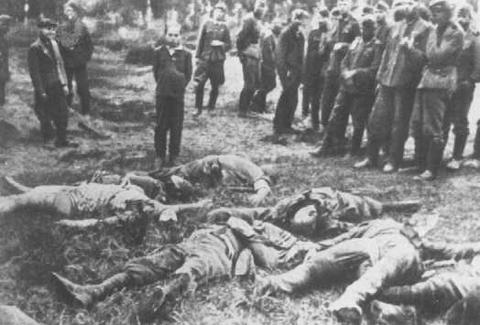The End of the Bloodiest War in History: Part III

Part II of our series on the human cost of the Second World War in Europe detailed Eastern Europe and Poland’s immense suffering. Part III now turns to the country that bore perhaps the worst of Nazi Germany's aggression; the Soviet Union and its Red Army.
Beginning with military losses, the Red Army suffered 29 million casualties during the Second World War; including 11,444,100 killed, missing, or captured with 8,668,400 killed in action. These figures utterly dwarf those of any other of the war’s major military establishments. Even capture meant death for much of the War. By May 1, 1944 some 2,420,000 Soviet prisoners of war had been killed or executed by the Germans; from a total of 5,163,381 captured. By the end of the war, the Axis powers had captured 5.7 million Soviet soldiers in total with 3.3 million either murdered outright or dying in captivity. In comparison, the Wehrmacht took 232,000 British and American soldiers as prisoner of war and only 8,348 died in German captivity; a statistic further demonstrating how much the German war in Eastern Europe was a racial war of hatred and extermination. Of course, Stalin was also quite barbaric toward his own people – including against even those that sacrificed the most to defend the Soviet experiment.
For instance, of the 1,833,567 prisoners of war returned to the Soviet Union after the war, Stalin sent 1.5 million to forced labor and the Gulags. Within the post-war Red Army Stalin resurrected the purges; 135,056 men and officers were convicted of “counter-revolutionary crimes” in 1945 alone. By the end of the War Stalin’s leadership had long since been as cruel and ruthless as was Hitler’s against his own armed forces with 158,000 Soviet soldiers receiving death sentences during the War. Even the highest ranking Soviet officials and military officers were not immune to Stalin’s ruthless paranoia. In 1946 the NKVD arrested the head of the Red Army Air Force, Alexander Novikov, and forced him to confess to accepting looted goods from the front lines – a “crime” millions of Soviet men and officers were encouraged to commit during the war. During his confession, he implicated Hero of the Soviet Union, Marshal Georgy Zhukov for participating in several politically dangerous conversations. Thus, Zhukov found himself exiled to the Odessa Military District following the War; lest his immense popularity pose a threat to Stalin’s rule.
Stalin also arrested or removed from power thousands of Leningrad’s former defenders – anxious as Stalin was that they had enjoyed their freedom from Moscow’s oversight during the horrendous three-year siege of the city. Alexei Kuznetsov, second in command during the Leningrad siege, was arrested, tortured and shot. Stalin’s purges went to the very top of the Communist Party elite. He even had Molotov’s wife arrested in 1949.
As for civilian suffering in general - Jewish civilians within the Soviet Union suffered horribly both during and after the war. An estimated 7 million non-Germans, predominantly European Jews, died at Nazi hands, mostly during the years 1941-44. A huge number of these Jews came from within the Soviet Union (the image with this post shows members of a German Einsatzkommando before shooting a Jewish youth. The boy's murdered family lies in front of him; the men to the left are ethnic Germans aiding the squad. Slarow, Soviet Union, July 4, 1941 - image courtesy of US Holocaust Museum). For the Holocaust’s survivors, though finding themselves freed from fear of genocide at Nazi hands, they were condemned to face Stalin’s anti-Semitic pogroms; characterized by beatings, random death, and other forms of ethnic persecution. Other ethnic groups within the Soviet empire also faced mass deportations and death both during and after the war including Chechens, Tatars, Volga Germans, Ukrainians, and more...
As for German predations against the Soviet people, civilian deaths from the Nazi invasion and occupation of a land mass comparable to the entire continental United States from just west of the Mississippi to the Atlantic Coast are still inexact. Some estimates put the total deaths suffered by the Soviet Union during the war at over 35 million human beings, including 16-17 million civilians. Most estimates indicate as many as 27-29 million people from the former Soviet Union lost their lives in the War. This from a war claiming over 55 million lives. The impact from the war lingered for years afterward. In the Western Soviet Union the Germans had decimated the male population - there were 20 million more women than men in the Soviet Union following the War. In 1946 one million Soviet citizens starved to death because of a poor harvest arising from the devastation in the Soviet Union’s best agricultural regions and endemic malnutrition plaguing the nation. In part and as a result it is now estimated by some that the Soviet Union’s 1950 population was nearly 50 million human beings less than it should have been had the 1941-45 war not happened. To draw a useful comparison to the Soviet Union’s superpower competitor following the war; in 1939 the Soviet Union’s population was roughly 170 million people versus 130 million people in the United States of America. Following the war however, the U.S. population not only pulled ahead of the Soviet Union’s but also left it far behind. Many today believe the seeds of the Soviet Union’s eventual collapse were sown during World War II; a war from which it never really recovered. Part IV of our series, the final part, will look at the nation most responsible for plunging humanity into global warfare: Germany.



Post new comment